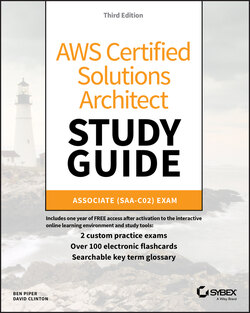Читать книгу AWS Certified Solutions Architect Study Guide - Ben Piper, David Higby Clinton - Страница 49
Instance Types
ОглавлениеAWS allocates hardware resources to your instances according to the instance type—or hardware profile—you select. The particular workload you're planning for your instance will determine the type you choose. The idea is to balance cost against your need for compute power, memory, and storage space. Ideally, you'll find a type that offers exactly the amount of each to satisfy both your application and budget.
Should your needs change over time, you can easily move to a different instance type by stopping your instance, editing its instance type, and starting it back up again.
As listed in Table 2.1, there are currently more than 75 instance types organized into five instance families, although AWS frequently updates their selection. You can view the most recent collection at aws.amazon.com/ec2/instance-types.
TABLE 2.1 EC2 instance type family and their top‐level designations
| Instance type family | Types |
|---|---|
| General purpose | A1, T3, T3a, T2, M6g, M5, M5a, M5n, M4 |
| Compute optimized | C5, C5n, C4 |
| Memory optimized | R5, R5a, R5n, X1e, X1, High Memory, z1d |
| Accelerated computing | P3, P2, Inf1, G4, G3, F1 |
| Storage optimized | I3, I3en, D2, H1 |
General Purpose The General Purpose family includes T3, T2, M5, and M4 types, which all aim to provide a balance of compute, memory, and network resources. T2 types, for instance, range from the t2.nano with one virtual CPU (vCPU0) and half a gigabyte of memory all the way up to the t2.2xlarge with its eight vCPUs and 32 GB of memory. Because it's eligible as part of the Free Tier, the t2.micro is often a good choice for experimenting. But there's nothing stopping you from using it for light‐use websites and various development‐related services. T2s are burstable, which means you can accumulate CPU credits when your instance is underutilized that can be applied during high‐demand periods in the form of higher CPU performance.M5 and M4 instances are recommended for many small and midsized data‐centric operations. Unlike T2, which requires EBS virtual volumes for storage, some M* instances come with their own instance storage drives that are actually physically attached to the host server. M5 types range from m5.large (2 vCPUs and 8 GB of memory) to the monstrous m5d.metal (96 vCPUs and 384 GB of memory).
Compute Optimized For more demanding web servers and high‐end machine learning workloads, you'll choose from the Compute Optimized family that includes C5 and C4 types. C5 machines—currently available from the c5.large to the c5d.24xlarge—give you as much as 3.5 GHz of processor speed and strong network bandwidth.
Memory Optimized Memory Optimized instances work well for intensive database, data analysis, and caching operations. The X1e, X1, and R4 types are available with as much as 3.9 terabytes of dynamic random‐access memory (DRAM)‐based memory and low‐latency solid‐state drive (SSD) storage volumes attached.
Accelerated Computing You can achieve higher‐performing general‐purpose graphics processing unit (GPGPU) performance from the P3, P2, G3, and F1 types within the Accelerated Computing group. These instances make use of various generations of high‐end NVIDIA GPUs or, in the case of the F1 instances, an Xilinx Virtex UltraScale+ field‐programmable gate array (FPGA—if you don't know what that is, then you probably don't need it). Accelerated Computing instances are recommended for demanding workloads such as 3D visualizations and rendering, financial analysis, and computational fluid dynamics.
Storage Optimized The H1, I3, and D2 types currently make up the Storage Optimized family that have large, low‐latency instance storage volumes (in the case of I3en, up to 60 TB of slower hard disk drive [HDD] storage). These instances work well with distributed filesystems and heavyweight data processing applications.
The specification details and instance type names will frequently change as AWS continues to leverage new technologies to support its customers' growing computing demands. But it's important to be at least familiar with the instance type families and the naming conventions AWS uses to identify them.
